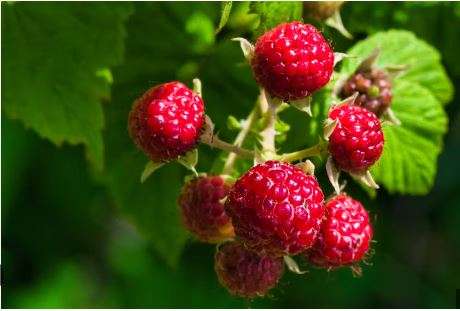This article provides a unique and comprehensive guide on how to plant raspberries from seeds. To get the most out of this guide, make sure you read it carefully to the end. Like planting flame seedless grapes, it is as joyful as growing a raspberry from seed.
Cultivating these delicious berries from scratch not only provides a rewarding gardening experience but also ensures you have fresh, organic fruit right from your backyard. This comprehensive guide will walk you through how to plant raspberries from seeds, along with valuable insights on raspberry history, nutritional facts, propagation methods, and care tips. Let’s dive in!
The History of Raspberries

Even as we think of how to plant raspberries from seeds, understanding the history of raspberries is critical.
Raspberries have a rich history dating back thousands of years. Originating from Eastern Asia and Europe, they were first cultivated by the ancient Greeks and Romans.
Over time, raspberries spread across the globe, becoming a popular fruit in gardens and farms. Today, they are prized for their sweet-tart flavor and versatility in culinary uses.
Raspberry Nutritional Facts
As we continue with the topic of the day – how to plant raspberries from seeds, it is essential to understand the nutritional value of these precious fruits. Raspberries are not only delicious but also packed with nutrients. They are an excellent source of:
- Vitamin C: This powerful antioxidant boosts the immune system, helps the body absorb iron, promotes healthy skin, and aids in the repair and growth of tissues.
- Dietary fiber: Fiber is crucial for digestive health, helping to prevent constipation and promote regular bowel movements. It also aids in maintaining a healthy weight by keeping you feeling full longer and can help lower cholesterol levels.
- Manganese: This mineral is vital in bone formation, clotting, and inflammation reduction. It also helps the body metabolize carbohydrates, amino acids, and cholesterol.
- Antioxidants: Raspberries contain various antioxidants, including quercetin and ellagic acid. These compounds help neutralize free radicals in the body, reducing oxidative stress and potentially lowering the risk of chronic diseases such as heart disease, cancer, and neurodegenerative disorders.
How Many Raspberries Should I Eat a Day

Consuming raspberries daily can be beneficial for health. A standard serving size is about one cup (approximately 123 grams), which contains around 64 calories. This serving provides a significant amount of the daily recommended intake of vitamins and fiber. However, individual needs may vary, so adjusting based on your dietary requirements and preferences is best.
How to Propagate Raspberries
There are three main methods of propagating raspberries, namely:
Propagating Raspberries from Runners

Raspberries naturally propagate through runners, which are shoots that sprout from the main plant. To propagate from runners:
- Identify healthy runners with strong roots.
- Gently dig up the runner without damaging the roots.
- Replant the runner in a prepared garden bed or pot.
- Water thoroughly and ensure the new plant receives adequate sunlight.
Compare: How Many Strawberry Plants Per Square Foot?
How to Plant Raspberries from Seeds
Learning how to plant raspberries from seeds is a rewarding technique every gardening aficionado should embrace. The process requires patience and care. Follow these steps to grow your raspberries from seed:
- Seed Preparation: Begin by soaking raspberry seeds in water for 24 hours to soften the seed coat.
- Stratification: Place the seeds in a damp paper towel and store them in a plastic bag in the refrigerator for 4-6 weeks. This simulates winter conditions and improves germination rates.
- Planting: After stratification, plant the seeds in seed-starting trays filled with a quality seed-starting mix. Sow the seeds about 1/4 inch deep and cover lightly with soil.
- Germination: Place the trays in a warm, sunny location or under grow lights. Keep the soil moist but not waterlogged. Seeds typically germinate in 2-4 weeks.
- Transplanting: Once seedlings have grown a few inches tall and have several sets of leaves, transplant them into larger pots or directly into the garden. Ensure they are spaced about 18-24 inches apart.
Related: How to Grow Watermelon
How to Propagate Raspberries from Cuttings
Propagating raspberries from cuttings is another effective method. Here’s how:
- Cutting Selection: Choose healthy, mature raspberry canes that are disease-free.
- Cutting Preparation: Cut 6–8-inch sections from the canes, ensuring each cutting has at least one node.
- Planting: Dip the cut end of each cutting in rooting hormone and plant it in a pot filled with a well-draining potting mix.
- Rooting: Keep the soil moist and place the pots in a warm, indirect sunlight location. Roots should develop in a few weeks.
How to Root Raspberry Cuttings in Water

Rooting raspberry cuttings in water is a simple propagation method:
- Cutting Preparation: Select healthy canes and cut 6–8-inch sections.
- Water Placement: Place the cuttings in a jar of water, ensuring the lower nodes are submerged.
- Root Development: Change the water every few days to prevent stagnation. Roots should start forming within a couple of weeks.
- Transplanting: Once roots are a few inches long, transplant the cuttings into pots or directly into the garden.
Also read: 8 Reasons Your Strawberry Leaves Are Turning Red
How to Prune Raspberries
Pruning is essential for healthy raspberry plants and bountiful harvests. Here’s how to do it:
- Timing: Prune summer-bearing raspberries after the harvest in late summer. For everbearing varieties, prune in early spring.
- Cane Selection: Remove all dead, damaged, and weak canes. For summer-bearing types, cut back old canes that have fruited. Trim the canes to the ground after the fall harvest for everbearing types.
- Spacing: Ensure canes are spaced to allow good air circulation, which helps prevent diseases.
How to Plant Raspberries from Seeds FAQs
Q: How long does it take to grow raspberries from seed?
A: Growing raspberries from seed can take about 18-24 months from planting to fruiting. Patience is key.
Q: Can I grow raspberries from store-bought fruit seeds?
A: You can use seeds from store-bought raspberries, but they may not be true to the parent plant. For best results, use seeds from a trusted source.
Q: What are the ideal growing conditions for raspberries?
A: Raspberries thrive in well-draining soil, full sun, and moderate temperatures. They prefer slightly acidic soil with a pH of 5.5-6.5.
My Final Thoughts on How to Plant Raspberries from Seeds
I am sure this guide on how to plant raspberries from seeds will change how you’ve been doing things. Seeing raspberry from seed to become a fully-grown fruit tree is a fulfilling gardening endeavor that rewards you with delicious, home-grown berries.
Whether you choose to propagate from runners, cuttings, or seeds, understanding the right techniques on how to plant raspberries from seeds and care practices is essential. With patience and dedication, you’ll enjoy bountiful raspberry harvests year after year.

